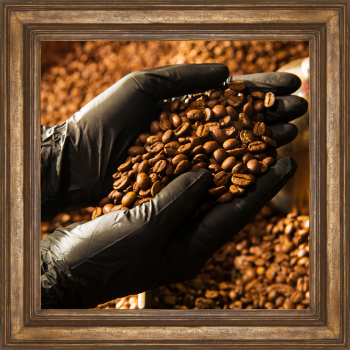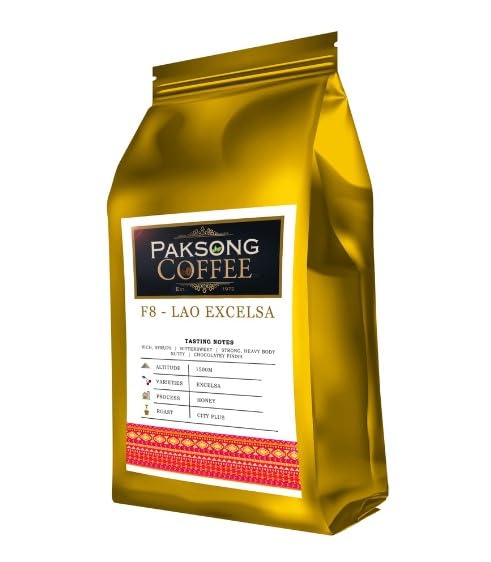If you purchase something from one of our links, we make a small commission. So in essence, you may have just got me a cup of coffee! Thank you! This will in no way have an impact on the price of the item...
I’m here to help you explore the enchanting world of excelsa coffee, a rare gem discovered in Africa around the dawn of the 20th century. This isn’t just about unearthing a new coffee species; it’s also about appreciating a coffee variety that stands out for its resilience and scarcity.
The minimal presence of excelsa coffee in the global market is a curious phenomenon. Why so? Part of the puzzle lies in the fact that we have little solid data on how much of it is traded, or on the specifics of its roasting and brewing methods due to the small quantity of beans that make their way to marketplaces.
I’m going to guide you through what makes excelsa coffee so uncommon. You’re going to find out about its remarkable traits that, despite its productive nature, haven’t yet made a significant mark on the coffee industry. This includes an insight into the uniqueness that makes excelsa not just another coffee bean, but a potentially transformative one for connoisseurs and producers alike.
By the end of this article, you’ll have a better understanding of excelsa coffee’s journey from a little-known African discovery to its current status. And that’s crucial, because as we step into the second section, we’ll delve into why excelsa has often been misunderstood and misprocessed, affecting its cultivation and the rich flavors it can offer.
The Hurdle of Misunderstanding in Excelsa Cultivation
In my opinion, one of the critical barriers that Excelsa coffee faces is a significant misunderstanding surrounding its cultivation. Interestingly, while it’s widely spread throughout Africa and Asia, many farmers seem to struggle with the plant’s mystifying origins.
You’re going to find out that incorrect cultivation techniques, along with improper processing and roasting, contribute to a misconception of excelsa as an inferior coffee. This misconception stems from a lack of knowledge on how to highlight its innate, distinctive flavors.
Imagine a scenario where excelsa beans — full of potential — end up misprocessed due to patchy information on its origins and best practices. Consequently, the resulting brew lacks the depth and character that excelsa could provide, leading consumers to undervalue these beans.
I’ll tell you about the frustration of diligent coffee enthusiasts who come across such misprocessed beans. Their experiences reflect a lost opportunity to savor what could have been a remarkable cup.
The connection between the bean’s origin and how it should be approached is crucial. I believe that, without understanding this link, the potential for high-quality results in taste and aroma is significantly limited by the processing stage.
Harnessing Excelsa’s Potential for Exquisite Flavor
I’m going to reveal how the full potential of excelsa coffee’s flavor can be brought to life. This isn’t just about adhering to standard farming practices; it’s also about understanding the uniqueness of the excelsa bean. With proper processing—including the all-important picking, drying, and fermenting stages—excelsa can yield a taste profile that’s both complex and highly sought-after by coffee connoisseurs.
You’re going to find out about farmers who have hit the sweet spot with excelsa. There are those who have fine-tuned their methods, reaping beans with flavors that defy the norm. Imagine sipping on a brew that offers subtle hints of tart fruitiness mingling with earthy, woody undertones. Some have even reported a delightful, unexpected twist of popcorn-like notes!
In my opinion, to appreciate the true breadth of excelsa’s flavor nuances, we must compare it directly with other coffee species. Whereas arabica beans are prized for their sweet, often fruity notes, and robusta for its bold, sometimes bitter profile, excelsa stands out with its own signature flavors. This distinction not only helps excelsa carve its niche in the diverse world of coffee but also provides a beacon for growers to aim for quality, not just quantity.
Don’t worry too much about excelsa taking over your favorite coffee anytime soon, though. Transitioning to the next section, we’ll explore the challenges that hold back excelsa from widespread adoption. Despite its potential for quality, this gem remains shrouded in market confusion, much like a rare bird that’s seldom seen. How does this ambiguity affect excelsa’s standing in the global coffee scene, and what can be done to ensure it gets the recognition it deserves? Stay tuned, because that’s the strategy I like to leverage: transparency leading to transformation.
Navigating the Market Maze: Challenges for Excelsa Coffee
You’re going to find out about the tangled web that is the excelsa coffee market, which can be as complex as the coffee’s own flavor profile.
In this case, it’s about how excelsa coffee is categorized by those in the coffee industry. Traditionally, excelsa was considered its own species. However, in 2006, it was reclassified under the liberica family. This shift threw a wrench into how the coffee is marketed and understood.
Well, there’s two ways to react to this. Farmers and sellers might label excelsa as liberica to align with official taxonomies, or they might continue using the old classification to maintain the coffee’s distinct identity. Both choices lead to a generalization that often results in a dip in perceived quality.
In my opinion, much of the confusion surrounding excelsa coffee also comes from the sidelines – there’s no uniform set of guidelines for production or trade. The International Coffee Organization (ICO), a prominent figure in coffee standards, has yet to recognize excelsa as a significant player, largely due to its minuscule share in global coffee commerce.
The big picture here is the ripple effect this neglect has: without official recognition, excelsa struggles to secure a spot in the competitive coffee market. There’s a lack of investment in farming practices, which affects quality control and hinders the bean’s full potential from being realized.
A lot is happening very quickly, and excelsa coffee is at a crossroads. The next step is crucial, and that’s going to include carving out a niche within the specialty coffee market. There’s a real potential for growth, but it’ll require effort from the ground up – literally.
The Future Brews Bright: Prospects for Excelsa in the Specialty Coffee Market

So, what’s on the horizon for excelsa coffee? It’s clear that this unique bean holds a lot of promise, especially within the specialty coffee market where uniqueness and quality are the prized endgame. However, hurdles such as low market visibility and the challenges of standardizing cultivation practices remain.
I’m going to say this outright: education is key. Increasing awareness among coffee producers and consumers can illuminate the path forward for excelsa. By understanding its distinct profile and the specialized techniques required for its cultivation and processing, we can start to untangle the confusion that currently surrounds this product.
Research and experimentation are already underway in some corners of the globe, helping to refine the best practices for growing and roasting these beans. This means that, with time, we might see excelsa making a name for itself as the bean of choice for coffee connoisseurs looking for the next big thing.
There’s a lot of opportunity in adopting and perfecting excelsa coffee cultivation, particularly for regions affected by climate change. Its adaptation to lower altitudes could be a game-changer, not to mention the grafting possibilities for enhancing disease resistance.
On top of this, the specialty coffee market’s emerging interest in excelsa presents not just challenges, but also the potential for a lucrative niche. But this will require collaboration across the industry—from harvesters to baristas—to establish standards and ensure fair pricing.
Just don’t focus too much on perfection right away. Your first attempt at brewing a cup of excelsa might not reveal its full potential, but that’s part of the journey. What’s crucial is harnessing curiosity and an openness to innovation, because excelsa’s true breakthrough is just around the corner. I really hope that you’ll give this rare gem a chance to shine in your next coffee exploration.

Brandyn hails from Minnesota. His passions include, drawing portraits, Researching, Writing, and of course, COFFEE!!! When he’s not drinking coffee, he’s learning how to make his next cup even better. He writes down everything he learns and shares them on his website “ReigningCoffee.com”. If he’s not writing or researching, he’s probably drawing. His goal is to help you enjoy your coffee, even more than you already do.


